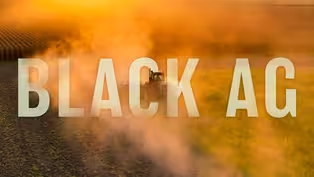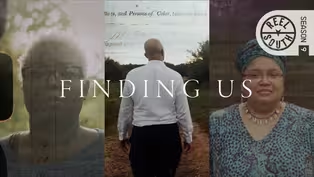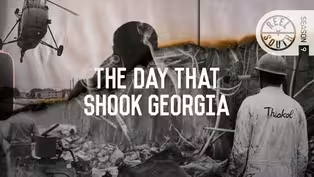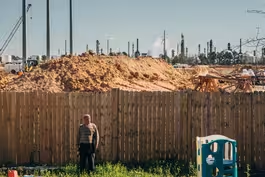
Quilted Education
Season 8 Episode 805 | 9m 51sVideo has Closed Captions
Karen Hinton Robinson quilts the Black history lessons absent from the Texan curricula.
In a time when books are banned and discussions around race are curtailed, Karen Hinton Robinson takes on the responsibility of teaching Black history beyond the institution. In this mother-daughter interview, the historian and skilled quilter explains how her craft is used to supplement education by creating quilts that document the important figures of Black history, missing in Texas schools.
Problems playing video? | Closed Captioning Feedback
Problems playing video? | Closed Captioning Feedback
Support for Reel South is made possible by the National Endowment for the Arts, the Center for Asian American Media and by SouthArts.

Quilted Education
Season 8 Episode 805 | 9m 51sVideo has Closed Captions
In a time when books are banned and discussions around race are curtailed, Karen Hinton Robinson takes on the responsibility of teaching Black history beyond the institution. In this mother-daughter interview, the historian and skilled quilter explains how her craft is used to supplement education by creating quilts that document the important figures of Black history, missing in Texas schools.
Problems playing video? | Closed Captioning Feedback
How to Watch REEL SOUTH
REEL SOUTH is available to stream on pbs.org and the free PBS App, available on iPhone, Apple TV, Android TV, Android smartphones, Amazon Fire TV, Amazon Fire Tablet, Roku, Samsung Smart TV, and Vizio.
Providing Support for PBS.org
Learn Moreabout PBS online sponsorshipMore from This Collection
Reel South honors the history of Black Texans and the new federal holiday marking the end of slavery in the South.
Video has Closed Captions
A Black scientist in Arkansas guides farmers through agricultural challenges. (8m 54s)
Video has Closed Captions
Families torn apart by Georgetown’s sale of enslaved people reunite six generations later. (13m)
Video has Closed Captions
In 1971, one of the worst industrial tragedies in U.S. history shook rural Georgia. (21m 10s)
Mossville: When Great Trees Fall
Video has Closed Captions
One man standing in the way of a petrochemical plant expansion refuses to give up. (56m 4s)
Providing Support for PBS.org
Learn Moreabout PBS online sponsorship[gentle music] - If we don't know our history, no one else is going to teach it to us.
It's our responsibility to teach our children and it's our responsibility to pass it along.
[gentle music] ♪ When you are a quilter, it's something that happens in your brain.
Everywhere you go, you see a quilt.
You can go in a store and look at the floor and that pattern makes you think of a quilt design.
♪ There's a particular person or there's a particular event that happens, I wanna capture it in a quilt.
♪ - When I was in college and I was changing my major to advertising, I was having a full-on meltdown about the impending conversation with my mom and she gave me nothing but her full support.
- I thought, "I can't object because I know nothing about advertising."
So the first thing I did is start to research advertising to see what contributions African Americans have made in the field of advertising.
And I stumbled upon a lady that many people don't know by the name of Nancy Green.
♪ She was actually a real person.
She was a former slave who became one of the first Black paid corporate models.
♪ I ended up making a Aunt Jemima quilt because I didn't know about Nancy Green.
I knew about Aunt Jemima and I know a lot of people know Aunt Jemima, so I wanted to tell her story for her and for her family.
I began sewing in seventh grade.
Back then, we took a class called FHA, Future Homemakers of America, which was a home economics class.
And I had been sewing a little bit as my mother liked to sew.
But in home economics, that's where I really learned the mechanics of sewing, the details of sewing.
The world just opened up for me.
It was just my thing.
I made my own clothes.
Short sets, dresses.
I made some bridesmaid dresses for some friends and I even made my own prom dress.
After I got married and we had our children, with my son, I started making short sets for him.
Let me see your T-shirt.
Let me see your T-shirt.
Wow.
Who made that nice T-shirt?
- You.
- But I really wanted to make dresses again.
So when we had our daughter, I started making.
Back then it was called Daisy Kingdom.
It was these fancy little dresses with petticoats and puff sleeves and lace and I just dressed her up to the nines.
Finally, she asked me not to make the puffy sleeves anymore because it itched her arm.
Then she didn't like the collar because it was too puffy.
Then she didn't like the petticoat.
And then she later just asked if she could wear jeans.
Broke my heart but I realized that it was stressing her out so I stopped making the fancy dresses.
But I knew I had to find another avenue for my creativity.
And so, that is what led me to quilting.
- [Kayla] Those dresses were itchy.
[Karen laughing] ♪ - When I first started, I liked creating something from start to finish.
Taking fabric, putting it together, different colors.
Creating something that someone could actually use.
And then a new idea presented itself.
We always had Black History at home.
It was just part of learning.
When my daughter was in fourth grade, she came home and she said she was a little upset because she said, "My teacher's not gonna teach Black History.
I asked him and he said he didn't have any books.
So mom, can I give him some of your books?"
And I said, "Sure."
A couple of days I didn't hear anything and then she came home and she said that he said that he didn't have time.
So of course, I was upset.
It rubbed me the wrong way, but I decided I wasn't gonna make a scene and embarrass anyone by going up to the school.
So I just kind of took a deep breath and decided I was gonna handle it differently.
And that was to end up making a quilt.
[piano music] ♪ ♪ [sewing machine sewing] I wanted to have something that I could use to teach not only my children, but maybe other children about Black History.
♪ It took over a year to make.
I had 64 people on the quilt.
It was eight categories.
We have great accomplishments in sports.
We have accomplishments in the military.
We have civil rights, science, politics, performing arts, literature.
And there was an other category because we had so many.
♪ I knew that the presentation had to be interesting, so I gave the teacher a list of all the people on the quilt and suggested that she'd make assignments or let the children select a name and do a report as well.
When I did the presentation, we had flashcards and I asked the children, "Who did their report on so-and-so?"
And asked them to tell me what they learned.
So it made it a lot fun.
Soon after the first year, the quilt sort of had its own calendar.
People started finding out about it and I was asked to come to different schools, libraries, churches, and other festivals to share the quilt with students.
- We don't showcase enough of what African Americans have done to contribute to this country.
I think about the gas mask.
Who invented that?
Garrett Morgan.
Think about the traffic light.
Daniel Hale Williams.
The first open heart surgery.
Kids don't know because they haven't been taught.
So I think as not just African-American educators, but as educators in whole, we need to expose them to all the wonderful things that African-Americans have done for the U.S. to make our lives easier and better.
[bongo music] - The project that I'm working on now is sourced from T-shirts.
It's a T-shirt quilt that I'm creating for Boggs Academy.
Boggs Academy is the high school that I attended in Keysville, Georgia.
It's the first Black boarding school.
The school since closed in the early '80s, so this quilt is going to be a raffle to raise money for scholarships.
♪ When people look at my work, I want them to learn something.
Quilting is a way to sneak in the teaching.
♪ If we don't know our history, no one will tell our story.
I accepted that responsibility for my children.
For the ones I gave birth to and the ones who just became my children by nature of me just loving them.
- [Kayla] For years you said you weren't creative.
You would constantly stop yourself from saying you were creative.
I wanna tell you that you, mommy, you are creative.
- Thank you.
[giggles] - And that's cut.
[gentle music] ♪ ♪ ♪
Support for PBS provided by:
Support for Reel South is made possible by the National Endowment for the Arts, the Center for Asian American Media and by SouthArts.



















